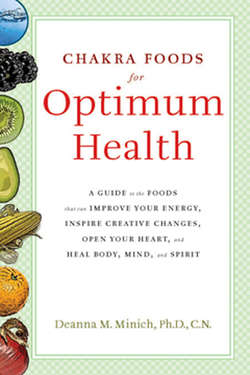Читать книгу Chakra Foods for Optimum Health - Deanna M. Minich - Страница 15
На сайте Литреса книга снята с продажи.
QUANTUM “PHOODS”
ОглавлениеIndeed, modern physics gives a whole new twist on how to view living matter. Essentially, all living organisms are compositions of cosmic, dynamic, responsive particles vibrating at a specific frequency. It has been said that the building block of life, the atom, is made of more than 90 percent empty space, implying that only about 10 percent of what is seen as the organism is actual reality. The chunk of most physical life-forms is vibrating energy. These particles of dancing matter form a web of connection, sending signals and creating patterns, vortices, and cascading effects. Therefore, when we think of ourselves as molecules in motion, it is highly plausible that the frequency generated by these interacting particles is modified by our thoughts, our words, the air we breathe, and even the food we eat. In support of this concept, many published research studies, such as those on meditation, prayer, visualization, and diet, support that our minds, words, and environment are powerful and, in ways beyond our understanding, influence emotional, mental, and physical makeup.
We are energy. Animals are energy. Plants are energy. Water is energy. Air is energy. It follows that foods created from animals and plants are energy. Just as each human being is multidimensional and complex, with layers upon layers of emotions, thoughts, history, and potential, so is each living organism. Each animal or plant is composed of the same fine vibrating matter, and like humans, some vibrate quickly and some more slowly. The vibration of food interacts with our inherent vibration, and an exchange of energy occurs. When we feel stuck in a way of thinking or move slowly through the day, eating beef, which carries slower vibrations, adds to our feelings of lethargy. However, when we eat a spicy black bean dish, with spices and beans carrying a higher resonance of energy than that of beef, we stay alert and energetic for hours after eating.
The fact that foods have vibrations is not new. The Bhagavad Gita classifies foods containing a relatively high energy vibration or promoting purity and vitality of body and soul as sattvic. They are not expensive for the body to process, and they do not leave behind harmful toxins. These foods are described as “savory, smooth, firm, and pleasant to the stomach” and are in contrast to foods that are rajasic or “excessively pungent, sour, salty, hot, harsh, astringent, and burnt” and lead to sickness. Examples of sattvic foods include those that are mild, cooling, and refreshing, such as fruits, vegetables, raw milk, clarified butter (known as ghee), and honey. Meats are perceived as rajasic, as the flesh is thought to harbor the fear and anger of the animal being killed, transferring it to the eater.
In modern society, there are foods considered to be toxic to our life energy. These foods have been damaged through processing, such as overcooking, burning, mechanical overprocessing, and oxidizing. Recent scientific studies have shown that foods that have been browned through cooking—such as the crust of bread or the brown color of baked products like waffles—age and inflame our cells. (When a protein and a carbohydrate are in the presence of heat, they form a compound that results in a brown color, known as a “Maillard reaction.”) Acrylamide and rancid fats are examples of toxic compounds that form in products like potato chips when the potato slices are heated in oil. Therefore, the manner in which food is prepared determines its vibration and its contribution to our energy. Meals made up of leftovers may seem convenient; however, many times they are devoid of any life-giving energy. Rather than give energy, they deplete energy.
The vibration of food interacts with our inherent vibration, and an exchange of energy occurs.
Food imparts its own healing vibrational energy, and it is responsive to external attitudes, thoughts, words, and actions, regardless of whether from plant or animal, or quick or slow vibration. In other words, we add to the vibration of foods through our thoughts, intentionally bumping up or eroding the healing transformation potential that is part of the food. By putting energy into food, we interact much more deeply with it during eating. If we put positive energy into it and have good thoughts while eating, the food transmits an exponential increase of positive energy in the eating process. On the other hand, if we are hurried, angry, or upset, these feelings transmit through foods into the body, down to the cellular level. Japanese researcher Masaru Emoto, Ph.D., demonstrated this idea best in his book, The True Power of Water. Although he is most recognized for his work on the responsiveness of water crystals to words, he did a series of experiments with cooked white rice. He put the cooked rice into two separate jars, one with a taped-on label with the Japanese characters for “You fool” and the other with a label of “Thank you.” Over time, the rice inside the jar labeled “You fool” turned black with decay while the rice labeled “Thank you” became yellow because of a lesser degree of degradation. Simply put, words carry energy and affect the vibration of food, causing it to take on that energy. Hence, even written words influence the energy of foods.
